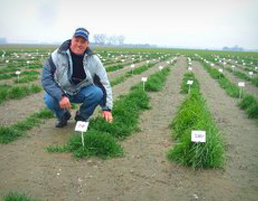Free Ground Delivery On Every Order.
Order by noon (Eastern) M-F, get same day shipment.
Find Delivery Time Here
Why choose our seed?
Plant breeders produce improved varieties, improved varieties produce a better lawn.
 The certified seed varieties, mixtures, and blends we sell are your assurance of a superior lawn that will beautify your property for years and years to come.
The certified seed varieties, mixtures, and blends we sell are your assurance of a superior lawn that will beautify your property for years and years to come.
Through the science of conventional plant breeding, turfgrass breeders select individual grass plants for quality, color, density, resistance to diseases and insects, tolerance to heat, cold and much more.
After years of selection and natural cross breeding of the strongest and most attractive plants, the new seed variety is examined by two independent expert panels to verify 1) uniformity, 2) uniqueness, 3) stability, and 4) eligibility for seed certification.
Remember, inferior turfgrass seed will never produce a superior lawn no matter how much time, effort and money you invest after planting.
Summer Watering
 Experts recommend infrequent deep watering (to 4 inch depth) rather than frequent light watering. This encourages root growth as the grass plant searches for ever deeper soil moisture between watering. As a rule of thumb turfgrass requires 1" of water per week-whether from rain or irrigation- to maintain healthy turf during warm growing conditions.
Experts recommend infrequent deep watering (to 4 inch depth) rather than frequent light watering. This encourages root growth as the grass plant searches for ever deeper soil moisture between watering. As a rule of thumb turfgrass requires 1" of water per week-whether from rain or irrigation- to maintain healthy turf during warm growing conditions.
You can tell when to water by the appearance of your lawn. When the leaf blades wilt and you leave shiny footprints as you walk on the lawn, its time to water
Most cool season grass plants go dormant under summer drought stress but return to full glory in the fall when temperature declines and rains return. Perennial ryegrass is more susceptible to drought damage than bluegrass, fine fescue and tall fescue.
Some homeowners in the northern climate have overseeded with heat tolerant hybrid bluegrass such as Bandera to improve summer performance.













